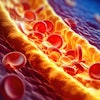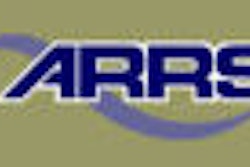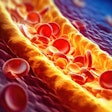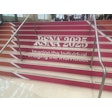CHICAGO - A new dual-source CT scanner -- using two sets of x-ray tubes and detector arrays -- is the RSNA highlight for multimodality vendor Siemens Medical Solutions. The Malvern, PA, company is also demonstrating recent advances in MRI, molecular imaging, PACS, ultrasound, and x-ray.
CT
Siemens launched the new dual-source scanner, called Somatom Definition, just 10 days before the RSNA meeting. The system tackles the issue of ever-faster CT scanning from a different angle than simply adding more slices to a detector array -- instead it adds a duplicate x-ray tube and detector array to double the system's speed, according to Bernd Ohnesorge, vice president of global CT sales and marketing.
The scanner employs the same technology used on the company's Somatom Sensation scanner, which collects 64 slices of data per rotation using 32-row detectors and the company's Straton x-ray tube, which uses a toggling focal spot to emit two x-ray beams simultaneously. The Straton design is more compact than a conventional x-ray tube, enabling the company to house two of the tubes in a gantry that's only slightly deeper than the company's single-source CT systems, Ohnesorge said.
Siemens sees major applications for Definition in cardiac and acute care environments, and also believes that new applications could emerge using the system's ability to scan with each x-ray tube set at a different energy. Such dual-energy scans could help clinicians characterize lesions based on the different energy absorption properties of different kinds of tissue.
Like Somatom Sensation, Definition sports 0.33-sec rotation times, and can conduct ECG-gated cardiac scans with a temporal resolution of 83 msec. The latter specification means that cardiac studies can be done on patients without beta blockers and on traditionally hard-to-image individuals, such as those with varying heart rates. Definition also features a 78-cm bore and a 200-cm scan range.
The first Definition installations will take place in early 2006, with general availability next summer.
Apart from Definition, Siemens touted its new Clinical Engines concept, designed to improve the workflow of users of its Definition, Sensation, and Emotion scanners. There are four modules in the Clinical Engines program, ranging from an acute care version that provides an extended field-of-view, up to 200 cm, for full-body diagnosis, to a cardiology module that simplifies diagnostic workflow and also provides motion-free imaging, according to the company. Neurology and oncology modules are also available.
Clinical Engines run on the company's CT Workplace and MultiModality Workplace computers, and are driven by the syngo CT.3D operating system.
Women's imaging
Breast tomosynthesis is a hot new mammography technology, and Siemens for the first time demonstrated a dedicated tomosynthesis system, Mammomat Novation Tomo, as a work-in-progress after just showing images at last year's RSNA show. The system is based on the company's full-field digital Mammomat Novation DR mammography unit, which has now been installed at 170 sites since it began shipping in 2004, according to Joanne Scott-Santos, women's health product manager.
Novation Tomo is capable of producing 11-49 tomo slices per acquisition, but Siemens believes that 15 slices might be the optimal number, according to Scott-Santos. The unit uses low-dose technology so that a 25-slice scan delivers a radiation dose equivalent to a conventional two-view mammography study. A prototype Novation Tomo unit is installed at Duke University in Durham, NC, where it's operating under Institutional Review Board approval.
In other digital mammography news, Siemens has upgraded its Novation DR system to accept an Opdima digital spot mammography unit. Opdima has been available on analog Novation units for some time, but the enhancement now makes Opdima's improved spatial resolution -- thanks to its CCD technology -- available to the company's FFDM installed base as well. Siemens expects that Novation DR users will use the Opdima for diagnostic applications in addition to the image guidance.
Siemens has also incorporated its syngo operating system into its mammography workstations, according to Scott-Santos. The company's acquisition workstations and MammoReport computers are now running on syngo, and the company is upgrading customers in the field.
Molecular imaging
This year's meeting marks the first RSNA show since Siemens acquired CTI Molecular Imaging in April 2005. A major highlight in the molecular imaging section of the company's booth is Biograph 64, a hybrid PET/CT scanner that uses 64-slice CT technology. The first Biograph 64 is scheduled to begin shipping in the first quarter of 2006, according to Markus Lusser, vice president of worldwide sales and marketing for the company's molecular imaging division.
Siemens is also demonstrating its Symbia gamma camera, which can be upgraded to a SPECT/CT unit. The company's SPECT/CT models come in a single-slice version for attenuation correction, as well as two- and six-slice models.
Scenium is a new computer-assisted tool designed to help clinicians diagnose dementia cases. The application takes co-registered patient studies and compares them against a database of healthy normal patients. Scenium will be offered to the company's installed base of PET/CT systems, Lusser said.
Finally, Siemens is demonstrating its micro-PET scanner, designed for preclinical imaging in applications like drug development.
MRI
A highlight in the MRI section of the Siemens booth is syngo Expert-i, a new application that enables remotely located users to access and control an MRI scanner. Siemens is demonstrating the application by remotely logging in and controlling MRI scanners for demonstration scans at UCLA Medical Center, according to Laurie Fisher, marketing manager for high-field products.
Siemens is also demonstrating breast MRI CAD, thanks to its new relationship with CAD developer Invivo of Orlando, FL. The software is currently shipping. Another breast MRI enhancement is a new Matrix coil, according to the company.
On the applications side, Siemens is discussing new capabilities in the syngo family, such as syngo SWI (susceptibility-weighted imaging), a stroke imaging technique that allows for better depiction of bleeding in stroke and brain trauma patients, and syngo GRAPPA, a parallel imaging technique for use in applications that require high spatial resolution in a small field of view, according to Nancy Gillen, vice president of the company's MRI division. Other applications include syngo Space and syngo Reveal.
IT
Siemens is shining the spotlight on its syngo Suite portfolio, which brings together RIS, PACS, and postprocessing functionality in an integrated role-based workflow environment, said Kai Strasdas, manager of strategy and communications.
The syngo Suite includes syngo Imaging (an enterprise/department PACS that evolved from the vendor's previous Cosmos package), syngo Imaging XS (a department/modality PACS that evolved from Siemens' previous Sky network), syngo Workflow (a RIS that evolved from Siemens' Novius RIS), and syngo Dynamics (multimodality management of dynamic images that grew from the firm's previous KinetDx offering).
Suite works together with the vendor's Soarian healthcare information system, which offers a longitudinal clinical repository to provide clinicians with browser-based, real-time access to the complete patient record, Siemens said.
Imaging features Smart Select, a navigational tool designed to support the daily work of radiologists, according to the vendor. It also includes progressive loading and hanging protocol enhancements to speed image reading, postprocessing functions, and integration of all components, Strasdas said.
Workflow supports traditional RIS functions, handling radiological workflow from order entry to image and report distribution, he said. As part of Workflow, Siemens is showing two works-in-progress integrated portal packages, one for radiologists and one for referring physicians. These portals combine information traditionally located in a HIS, RIS, and PACS into a single user interface and workspace, Strasdas said.
Dynamics serves as a multimodality diagnosis and archiving system for dynamic images. It's scalable for imaging clinics, hospitals, and multifacility health enterprises, and features optional interfacing to clinical or hospital information systems.
Ultrasound
Siemens is highlighting the Encompass II release for its Sequoia scanner. Encompass II adds features such as an 18-inch, high-resolution LCD, a CD/DVD-R drive for viewing and exporting of exam data, and high-resolution color flow (HRCF) capability, said Barbara Del Prince, senior market manager of Asia Pacific.
HRCF applies Chirp-coded excitation to color Doppler to improve spatial resolution and sensitivity, she said. Specifically, it addresses color bleeding, slow-flow sensitivity, color penetration, vascular hemodynamics, and deep-flow identification, according to the vendor. Encompass II is available now.
Siemens is also discussing the next software release, Encompass III, a work-in-progress package that will add new means to extract and display myocardial mechanics from ultrasound information called Axius Velocity Vector Imaging (VVI), according to the firm. Siemens says that the quantitative motion analysis tool is intended for use with any transducer for all cardiovascular imaging applications.
Also making its RSNA debut is the premium edition of Siemens' Antares scanner. The system includes new features such as the vendor's fourSight 4D imaging technology, a suite of Hanafy lens and Multi-D array transducers, 2D and Spectral TEQ ultrasound technology, and the vendor's Clarify vascular enhancement technique. The premium edition also includes Extend imaging technology for difficult-to-image patients, and the company's Cadence contrast pulse-sequencing (CPS) contrast imaging option.
Siemens is also emphasizing developments with its transducer technology. The company plans to introduce 4Z1C, its first transducer employing its 2D Matrix Array technology, in the first quarter of 2006. 4Z1C is a probe for cardiac applications that can provide real-time 3D imaging, said Thomas Shoup, Ph.D., vice president of engineering.
The 2D Matrix Array technology yields clinical benefits such as a higher volume rate, improvements in 2D detail and contrast resolution, better penetration, and a compatible transducer size and weight for user comfort, according to Siemens.
The firm also discussed its silicon ultrasound transducer technology development program, aided by its June 2005 acquisition of Sensant. Siemens expects silicon ultrasound transducers will yield efficient volumetric 4D imaging for a wide range of applications, and allow for visualizing a greater level of detail within both conventional and volumetric 4D ultrasound images. Commercialization is expected within two years, Shoup said.
Digital x-ray
Siemens is debuting Axiom Aristos FX Plus, a digital radiography system suitable for both pediatric and adult applications.
Aristos FX Plus includes a number of enhancements over Aristos FX, including new drives and brakes that are twice as fast as before, said Gerhard Schmiedel, head of radiography solutions. It also features a redesigned detector housing for improved grid management, choice of adult- or pediatric-oriented tabletop designs, a 19-inch monitor, and wireless remote control capability.
With Aristos FX Plus, users can also now perform scoliosis and long-leg imaging, Schmiedel said. Shipments are expected to begin in January. Aristos FX Plus has a list price of approximately $650,000.
Siemens has also added orthopedic and trauma applications for its Axiom Multix M DR system. The new configuration allows clinicians to obtain digital images of critically ill and injured patients, Siemens said.
Finally, in fluoroscopy developments, Siemens is debuting Axiom Luminos TF. The system can support up to 600 lb in a locked horizontal position and 500 lb with table movement, Schmiedel said. It also features a 55-cm-wide opening between the table and the image intensifier, as well as ergonomic handles.
Axiom Luminos TF has an option for a mobile flat-panel detector, avoiding the need for film or computed radiography cassettes, he said. Scheduled to begin shipping in June 2006, Luminos TF will cost approximately $850,000 with the flat-panel detector, and about $550,000 without it.
By Brian Casey and Erik L. Ridley
AuntMinnie.com staff writers
November 29, 2005
Copyright © 2005 AuntMinnie.com



















